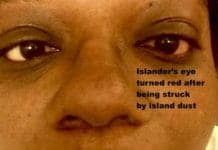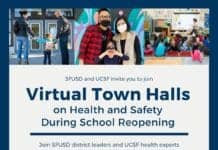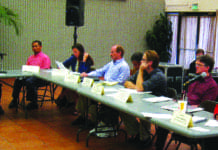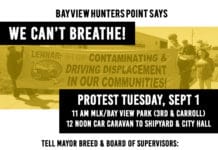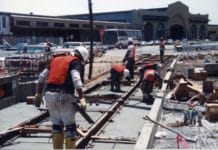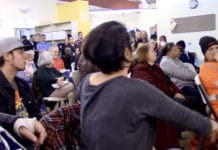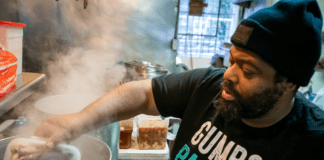
by M. Reza Shirazi
Community members have repeatedly blamed different entities involved in the remediation and re-development of the Hunters Point Shipyard for excluding residents from decision-making, being non-transparent and non-responsive, miscommunication, misconduct and negligence.
These entities include a number of federal, state and city agencies as well as private companies – the Navy, the City, Environmental Protection Agency (EPA), California Department of Toxic Substances Control (DTSC), San Francisco Bay Area Regional Water Quality Control Board (RWQCB), California Department of Public Health (CDPH), San Francisco Department of Public Health (SFDPH), San Francisco Office of Community Investment and Infrastructure (OCII), San Francisco Board of Supervisors, Lennar, Five Point, Tetra Tech etc.
Now, UC Berkeley (UCB) and UC San Francisco (UCSF) have proved to be no better than these agencies, if not worse!
The story began when Mayor London Breed in her 2019 State of the City address noted that the City should be “clear and transparent with the public” about the Hunters Point Shipyard project. She announced that representatives from UCB and UCSF will put together a team to review the procedures used by the Department of Public Health during 2018 for retesting Parcel A, and also comment on new plans for Parcel G after the Navy and EPA confirmed data falsification conducted by Tetra Tech in the shipyard remediation project.
Community members, activists, media and even faculty members at UC Berkeley were curious to know who these representatives are and what their plan is. More importantly, the question was why community members have not been consulted – the same people who have been on the front lines of the fight for environmental justice and demanding transparency and community oversight.
On April 17, 2019, a press release from the Mayor’s Office provided some details, and later I managed to obtain more details about the committee, the charge and the scope of the “independent review.” I published an article, made all the documents available to the public, criticized the procedure and the scope of the review, and warned the committee not to walk into the “toxic land” of distrust, namely the Hunters Point Shipyard, without being inclusive and transparent.
There was no news about this committee until Dr. Balmes, a committee member, attended a July 17 Hunters Pont Shipyard Citizen Advisory Board Environmental and Reuse Subcommittee meeting to inform the audience about the independent review. At this meeting, participants raised critical concerns, asked serious questions, and demanded revisiting the review plan and procedure if the committee wants to do a truly independent review.
Mayor London Breed in her 2019 State of the City address noted that the City should be “clear and transparent with the public” about the Hunters Point Shipyard project. She announced that representatives from UCB and UCSF will put together a team to review the procedures used by the Department of Public Health during 2018 for retesting Parcel A.
I again noted that the committee has jumped into the toxic land, and should withdraw from doing the review unless the city agrees to develop a real and functioning review. Apparently, these arguments did not make sense for the committee: no response, no reaction, no news. The committee disappeared from public view.
On Aug. 26, more than one month after the July meeting, out of curiosity, I sent an email to Ms. Laura Kurtzman from the UCSF Office of Communications, who was introduced as the contact person for further inquiries. I wanted to know how the committee has decided to address community concerns raised in the July meeting. To be specific, I summarized community demands and requested a response to the following questions:
“First: If the goal of the meeting was listening to the community concerns and addressing them, please provide us with a document that shows how these concerns were summarized and addressed by the committee? What was the concrete outcome of the meeting?
“Second: Community members requested expanding the charge to make it more comprehensive. Does the committee intend to change the charge and plan? If so, what are the changes? If not, does this mean that no change is needed to address community concerns? Does the committee believe that the charges are enough and sufficient?
“Third: Community members requested extending the list of interviews to make it more inclusive. Professor Balmes noted that any change must be checked by the mayor and others who approved the charge. Was extending the interview list discussed? If so, what was the result? If not, why?
“Fourth: Community members also requested adding new members to the committee from the community (Professor Balmes described the committee as four old white men, which indicated that probably he was not happy with the composition of the committee). Is there any plan to bring new members to the committee? If so, please provide more details. If not, please explain why this request has been rejected.
“Fifth: Please provide more details about the progress of the work and the review timeline (e.g. next community meeting, presentation of the results etc.).”
After a gentle reminder, finally I received a rather short but interesting reply from Ms. Kurtzman on Sept. 6, which said: “The purpose of that session was to hear direct community input on the cleanup at the Shipyard” and continued “UCSF and UC Berkeley intend to release their final report this fall, which will be based on a review of documents, and discussions with state and federal regulators, as well as community experts. We welcome your review of the report when it is complete.”
Obviously, this did not respond to any of my questions. A committee member even commented that the response was “miserable”! I quit that fruitless communication.
Community members also requested adding new members to the committee from the community (Professor Balmes described the committee as four old white men, which indicated that probably he was not happy with the composition of the committee).
No updates were provided by the committee after the July meeting. I heard that representatives of regulatory agencies have been approached for interview and discussion. I also heard that requests from some knowledgeable persons who have worked for several years on this case for sharing their information and data have been ignored.
None of the whistle-blowers have been contacted for an interview. Even Dr. Daniel Hirsch, who was on the interview list, has not been contacted. I received inquiries from activists, media and colleagues asking whether I have any updates about the work the committee is conducting and when they will publish the report. My answer always was that I don’t know.
My last attempt to get updates from UCSF (Ms. Kurtzman) was Dec. 9, 2019. My email was responded to by Dr. Balmes, saying that the committee has written a report which will be released in the near future.
Finally, the report was released on Jan. 17, 2020. The report finds “the gamma scanning of the surface soil of Parcel A performed by the Radiological Health Branch of the CDPH to be appropriate as a health and safety survey.”
The committee suggests that “the City and County of San Francisco hold an informational meeting with the residents of Parcel A to discuss the cost and benefits of further radiation testing of the parcel.” With regard to Parcel G, the committee judges “the planned approach to retesting of Parcel G to be appropriate if the final plan meets with EPA approval.”
I don’t want to challenge these findings, because it is not my expertise to comment on the technical aspects of the results. I know that the report will not surprise the community members and most of the audience at the July meeting; they had this presumption, and expressed it during the meeting, that the committee will finally approve the official narrative.
It is the responsibility of the committee members, and also of the City authorities who “appointed” the committee, to explore why community members had such a strong presumption. I have already discussed why this is the case and warned that, in a context of absolute distrust, actions should be performed differently and carefully, and the old strategies and avenues of action should be fundamentally revisited and revised.
None of the whistle-blowers have been contacted for an interview. Even Dr. Daniel Hirsch, who was on the interview list, has not been contacted.
I believe the committee failed to recognize and acknowledge the governing distrust and decided to walk along the old avenues and perform along the failed strategies. This is another story and needs to be discussed in a separate article. Here, I would like to make a statement, a comment and a clarification.
In planning and design disciplines, like many other fields of knowledge, we use the terms “best/good practice” and “bad practice” to discuss case studies that have been successful or unsuccessful in their design, operation and implementation. This helps students and the wider audience to get familiar with live projects and real cases, and learn from their achievements and failures.
As noted, I am not an expert in radioactive and health subjects. It is to the experts to comment on the technical content of the review, and they will do so. But one thing is clear to me. As an urbanist and urban planner, having worked globally in several countries, studied dozens of case studies and published widely on community-based research and works, I can tell with high certainty that, from a planning and urban policy perspective, the UC-led review was a “bad practice,” a terrible one!
You can hardly imagine a worse scenario, in which a leading university enters into a complicated, sensitive neighborhood with a record of historical injustice and systematic negligence, to provide scientific assessment on a subject that directly deals with the health and safety of thousands of mainly disadvantaged people and generations to come, yet fails to address concerns and demands of community members.
Why do I believe the UC-led review was a “bad practice” from an urban planning and urban policy perspective? Here I list a number of reasons:
The committee failed to conduct an “independent” review. An “independent” review requires possessing an independent position in developing the methodology and designing the charge.
For this review, the committee served as an “operator,” to do what it was asked to do, rather than defining what actually needs to be done. The charge was defined to meet the City’s concerns, not those of the community members and residents.
The committee failed to engage residents in designing the work plan in such a way that it responds to community questions based on a bottom-up procedure. A top-down method of decision-making has no place in contemporary urban policy, and this approach has failed and been rejected for over 40 years for being malfunctional and disabled.
The committee failed to include community members into the committee body. Taking into account the nature and history of the case, it was wrong to build a committee that consists of non-community members. A committee of four old white men (this is how Dr. Balmes characterized the committee in the July meeting) without inviting knowledgeable community members to join the team is far beyond a functioning body that wants to address the problems of a diverse community like Bayview Hunters Point.
The committee failed to respond to serious concerns, requests and demands raised by the community in the July meeting. This indicates that the meeting was only to check the box, not to listen to the community to understand their problems and act accordingly.
The committee failed to update the community with regard to the progress of the work. There were no updates for about seven months, to the best of my knowledge, between the July 2019 meeting and Jan. 18, 2020, when the report was released.
The committee – and Ms. Kurtzman from UCSF as the person in charge of communications – failed to properly communicate when inquiries were made by the public (and myself) and respond to questions over the course of the review.
You can hardly imagine a worse scenario, in which a leading university enters into a complicated, sensitive neighborhood with a record of historical injustice and systematic negligence, to provide scientific assessment on a subject that directly deals with the health and safety of thousands of mainly disadvantaged people and generations to come, yet fails to address concerns and demands of community members.
We can continue this list of failures, but it is enough to call the review a “bad practice.” It was a “bad practice” regardless of the nature of the results.
Overall, the procedure for preparation and implementation of the review was exclusive, non-transparent and disrespectful to community concerns and demands. Whether the community accepts the results, and to what extent this review helps the residents of Parcel A and the wider community to feel safe is to be explored in the future.
Recommendations made by the committee at the end of the report are surprising. It says that “the committee became aware of the need to improve communications with stakeholders, especially current residents of Parcel A and people living in the Bayview neighborhood.” Then it talks about the “depth of mistrust” and advises the US Navy and other government agencies to “engage the community.”
Interestingly, the committee advises the Navy and others to properly communicate with the community and engage them, but does exactly the opposite: It excludes the community and neglects their demands! If miscommunication is an issue, why was there no effort to address these problems during the review period?
If the committee itself fails to engage the community, why should other agencies take this recommendation seriously? And if the committee believes that there is mistrust, why was there no attempt to remedy the mistrust and instead to add to it by conducting a non-transparent, exclusive review? These are serious questions that make the recommendations and advice of the committee more like deceptive rhetoric than a real, collective belief.
Finally, I need to clarify one point. The report says that I have been “interviewed” by committee member Dr. Smith. This is not accurate! We met on Aug. 28, 2019, upon his request for a “chat” after I sent my article to a mailing list that included him. This was not an interview, but an informal chat.
I raised the same concerns I discussed in the article, such as revising the charge, inviting some community members to the committee, and interviewing residents and activists, and noted that if they can’t do so, they had better withdraw from doing the work. Apparently, none of my comments were acknowledged by the committee.
In my previous article, I warned: “The Hunters Point Shipyard is not a normal toxic land; it is a ‘toxic maze.’ And the city was responsible for turning the ‘toxic land’ into a ‘toxic maze.’ You have to get prepared before entering into it! And when you are not prepared, you will get lost!”
The committee was not prepared, did not want to get prepared, and denied any change to the pre-defined path of action. The committee decided to act as an “operator” for the city administration, and then jumped into this “toxic maze,” buried under a thick cloud of distrust, and now has got lost.
The committee advises the Navy and others to properly communicate with the community and engage them, but does exactly the opposite: It excludes the community and neglects their demands!
The committee did so deliberately and should bear the consequences. We will hear soon about this loss! And the only good thing from this operation is that now we university teachers have a new case of “bad practice” to add to our long list to teach students.
May UCB and UCSF never jump into a toxic maze again! But I doubt they will change, as long as politics is the most decisive factor, rather than science and community.
Community meeting to discuss the report
Supervisor Shamann Walton will host a community meeting to discuss the report on Tuesday, Jan. 28, 2020, at 7:00 p.m. at 451 Galvez Ave. (the Storehouse at the Shipyard), San Francisco 94124. UC experts will be available to answer questions about the report. For more details, see: https://files.constantcontact.com/b822d400601/fb0ebea0-8a3d-452e-8cc5-e3c59e0becff.pdf.
M. Reza Shirazi is a Reader/Professor at the School of the Built Environment, Oxford Brookes University in the UK. He is principal investigator for the European Union-funded project “Socio-Spatial Justice in Urban Neighborhoods” in collaboration with Institute of Urban and Regional Development (IURD) at UC Berkeley. He is an expert in neighborhood and community development, citizen participation and sustainable development, and has conducted research in different countries and regions. He can be reached at shirazi@brookes.ac.uk.

 Store
Store



